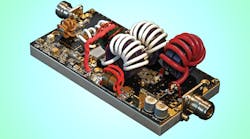This file type includes high resolution graphics and schematics when applicable.
High power levels are essential for many applications in the high-frequency (HF) range, including for communications and industrial-scientific-medical (ISM) systems. Electron tubes have traditionally supplied thousands or tens of thousands of watts of power for these applications, but solid-state solutions continue to gain ground in terms of high power from small packages.
As examples, models RFP2-30-500XR and RFP27.12-1000XR are amplifiers from RF and Microwave Power Technology, LLC capable of delivering 500 and 1000 W CW output power, respectively, at HF and assembled into thermally efficient modular configurations that enable system integrators to combine multiple amplifiers to achieve truly “tubelike” power levels in the HF range.
Both high-power amplifier modules are constructed with silicon laterally diffused metal-oxide-semiconductor (LDMOS) transistors. Both are impressive examples of how much power is possible from a small package when thermal management is properly applied. Model RFP2-30-500XR (Fig. 1) is the broadband, linear member of the pair, designed for use across the full frequency range from 2 to 30 MHz. It provides 500 W CW output power at 1-dB compression across that range. The Class-AB amplifier boasts generous typical gain of 26.5 dB, maintained to typical ±1.0-dB gain flatness across the full bandwidth.
The compact unit draws 15.6 A typical current from a +50 V dc supply and holds typical third-order intermodulation distortion (IMD) to -33 dBc for clear communications in HF military radios. As required for proper thermal management, the efficiency is high, at typically 64%. Amazingly, for such high output power, the amplifier module measures just 2.95 × 5.65 × 1.90 in. (74.93 × 143.51 × 48.26 mm). It employs temperature-compensated bias and, with its LDMOS active devices, includes a transistor-transistor-logic (TTL) disable function. It can be supplied in an open-pallet format with or without connectors, or in a ventilated module format with SMA input connectors and Type N output connectors.
For narrowband applications at twice the power, the model RFP27.12-1000XR amplifier module (Fig. 2) is a highly tuned and thermally optimized version of the RFP2-30-500XR for ISM systems at 27.12 MHz. This narrowband amplifier module is well suited for RF energy markets, with 1000 W CW output power at 3-dB compression. The nonlinear (saturated Class-B) amplifier design leverages the printed-circuit-board (PCB) design of the RFP2-30-500XR model, but achieves amazing typical efficiency of 84% through careful impedance matching and tuning. It provides 22-dB typical gain and, like its broadband, lower-power “partner,” features a TTL-controlled disable function.
The model RFP27.12-1000XR amplifier module runs on 23.8 A drain current at +50 V dc supply voltage. It is close in size to the model RFP2-30-500XR, at 2.95 × 5.65 × 2.10 in. (74.93 × 143.51 × 53.34 mm), and is available with SMA and Type-N connectors or with all Type N connectors. The high-power unit also incorporates temperature-compensated bias and can be supplied with a heatsink and fan where operation as an individual amplifier is desired.
Both high-power amplifier modules can be used as standalone amplifiers, and they offer the high efficiency that turns most of the applied bias energy into RF signal power, and not heat. But these small-footprint amplifiers are also excellent building blocks for systems in need of “serious” output-power levels in the multiple-kilowatt range, without having to expend all that saved energy into some way of dissipating excess heat. Both amplifiers have matched drivers available and are designed and built for high reliability in the most demanding military and industrial system applications.
RF and Microwave Power Technology, LLC, 2380 Solitude Dr., Reno, NV 89511; (775) 842-3280
This file type includes high resolution graphics and schematics when applicable.



